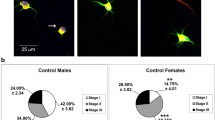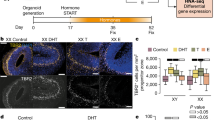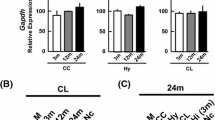Summary
In order to distinguish the effects of genetic sex from those of sex hormones on the sexual differentiation of dopaminergic neurons, catecholamine synthesis was studied in gender-specific cultures of embryonic day-14 rat diencephalon. In addition to embryos from normal dams, embryos were used whose mothers had been treated with the estrogen antagonist tamoxifen or the testosterone antagonist cyproterone acetate on days 12 and 13 of gestation. Cultures from embryos of untreated dams were fed daily with a medium containing 17β-estradiol or testosterone. After 10 days in vitro, cultures were immunostained for tyrosine hydroxylase and the accumulation of dihydroxyphenylalanine (DOPA) was measured in the presence of the DOPA decarboxylase inhibitor NSD 1015. Rates of DOPA synthesis, unlike the numbers of tyrosine hydroxylase-immunoreactive neurons, were markedly higher in female cultures under all experimental conditions. Treatment of dams with antisteroids prior to removal of the embryos had no influence on these results. Treatment of cultures with both steroids decreased DOPA formation in a dose-dependent manner without altering the sex difference. These results suggest that cultured diencephalic dopaminergic neurons develop sex differences in the activity of tyrosine hydroxylase. This sexual dimorphism is initiated independently of the action of gonadal steroid hormones. Sex hormones exert an additional modulatory influence on the activity of the enzyme but do not abolish or reverse sex differences. Therefore, the concept of a purely epigenetic mode of sexual differentiation of the mammalian brain needs to be broadened to incorporate other mechanisms, such as the cell-autonomous fulfillment of a sex-specific genetic program.
Similar content being viewed by others
References
Abreu P, Hernandez G, Calzadilla CH, Alonso R (1988) Reproductive hormones control striatal tyrosine hydroxylase activity in the male rat. Neurosci Lett 95:213–217
Ahnert-Hilger G, Engele J, Reisert I, Pilgrim Ch (1986) Different developmental schedules of dopaminergic and noradrenergic neurons in dissociation culture of fetal rat midbrain and hind-brain. Neuroscience 17:157–165
Arai Y, Gorski RA (1968) Critical exposure time for androgenization of the rat hypothalamus determined by antiandrogen injection. Proc Soc Exp Biol Med 127:590–593
Arita J, Kimura F (1987) Direct inhibitory effect of long term estradiol treatment on dopamine synthesis in tuberoinfundibular dopaminergic neurons: in vitro studies using hypothalamic slices. Endocrinology 121:692–698
Arnold AP, Gorski RA (1984) Gonadal steroid induction of structural sex differences in the central nervous system. Annu Rev Neurosci 7:413–442
Baum MJ, Woutersen PJA, Slob AK (1991) Sex difference in whole-body androgen content in rats on fetal days 18 and 19 without evidence that androgen passes from males to females. Biol Reprod 44:747–751
Berthois Y, Katzenellenbogen JA, Katzenellenbogen BS (1986) Phenol red in tissue culture media is a weak estrogen: implications concerning the study of estrogen-responsive cells in culture. Proc Natl Acad Sci USA 83:2496–2500
Beyer C, Pilgrim Ch, Reisert I (1991) Dopamine content and metabolism in mesencephalic and diencephalic cell cultures: sex differences and effects of sex steroids. J Neurosc 11:1325–1333
Blum M, McEwen BS, Roberts JL (1987) Transcriptional analysis of tyrosine hydroxylase gene expression in the tuberoinfundibular dopaminergic neurons of the rat arcuate nucleus after estrogen treatment. J Biol Chem 262:817–821
Brawer J, Bertley J, Beaudet A (1986) Testosterone inhibition of tyrosine hydroxylase expression in the hypothalamic arcuate nucleus. Neurosci Lett 67:313–318
Carlsson A, Davis JN, Kehr W, Lindquist M, Atack CV (1972) Simultaneous measurement of tyrosine and tryptophan hydroxylase activities in brain in vivo using an inhibitor of the aromatic amino acid decarboxylase. Naunyn Schmiedebergs Arch Pharmacol 275:153–168
Crowley WR, O'Donohue TL, Jacobowitz DM (1978) Sex differences in catecholamine content in discrete brain nuclei of the rat: effects of neonatal castration or testosterone treatment. Acta Endocrinol (Copenh) 89:20–28
Demarest KT, Moore KE (1980) Accumulation of L-dopa in the median eminence: an index of tuberoinfundibular dopaminergic nerve activity. Endocrinology 106:463–468
Demarest KT, McKay DW, Riegle GD, Moore KE (1981) Sexual differences in tuberoinfundibular dopamine nerve activity induced by neonatal androgen exposure. Neuroendocrinology 32:108–113
Döhler KD, Srivastava SS, Shryne JE, Jarzab B, Sipos A, Gorski RA (1984) Differentiation of the sexually dimorphic nucleus in the preoptic area of the rat brain is inhibited by postnatal treatment with an estrogen antagonist. Neuroendocrinology 38:297–301
Döhler KD, Coquelin A, Davis F, Hines M, Shryne JE, Sickmöller PM, Jarzab B, Gorski RA (1986) Fre- and postnatal influence of an estrogen antagonist and an androgen antagonist on differentiation of the sexually dimorphic nucleus of the preoptic area in male and female rats. Neuroendocrinology 42:443–448
Engel J, Ahlenius S, Almgren O, Carlsson A (1979) Effects of gonadectomy and hormone replacement on brain monoamine synthesis in male rats. Pharmacol Biochem Behav 10:149–154
Engele J, Pilgrim C, Kirsch M, Reisert I (1989a) Different developmental potentials of diencephalic and mesencephalic dopaminergic neurons in vitro. Brain Res 483:98–109
Engele J, Pilgrim C, Reisert I (1989b) Sexual differentiation of mesencephalic neurons in vitro: effects of sex and gonadal hormones. Int J Dev Neurosci 7:603–611
Eusterschulte B, Reisert I, Pilgrim C (1992) Absence of sex differences in size of the genital ducts of the rat prior to embryonic day 15.5–16.0. Tissue Cell 24:483–489
Fabre-Nys C, Adkins-Regan E (1987) Antisteroid action in brain and changes in animal behavior. In: Agarwal MK (ed) Receptor mediated antisteroid action. de Gruyter, Berlin, pp 435–468
Friedman WJ, Dreyfus CF, McEwen BS, Black IB (1989) Developmental regulation of tyrosine hydroxylase in the mediobasal hypothalamus. Dev Brain Res 48:177–185
Furr BJA, Jordan VC (1984) The pharmacology and clinical uses of tamoxifen. Pharmacol Ther 25:127–205
Gudelsky GA, Porter JC (1981) Sex-related difference in the release of dopamine into hypophysial portal blood. Endocrinology 109:1394–1398
Herdon HJ, Wilson CA (1985) Changes in hypothalamic dopamine D-2 receptors during sexual maturation in male and female rats.Brain Res 343:151–153
Kalra SP, Kalra PS (1983) Neural regulation of luteinizing hormone secretion in the rat. Endocrinol Rev 4:311–351
Kolbinger W, Trepel M, Beyer C, Pilgrim C, Reisert I (1991) The influence of genetic sex on sexual differentiation of diencephalic dopaminergic neurons in vitro and in vivo. Brain Res 544:349–352
Kordon C, Glowinski J (1972) Role of hypothalamic monoaminergic neurones in the gonadotrophin release-regulation mechanisms. Neuropharmacology 11:153–162
Lacau de Mengido I, Becú-Villalobos D, Libertun C (1987) Sexual differences in the dopaminergic control of luteinizing hormone secretion in the developing rat. Dev Brain Res 35:91–95
Leret ML, González MI, Tranque P, Fraile A (1987) Influence of sexual differentiation on striatal and limbic catecholamines. Comp Biochem Physiol 86C:299–303
Lloyd T, Weisz J (1978) Direct inhibition of tyrosine hydroxylase activity by catechol estrogens. J Biol Chem 253:4841–4843
Luine VN, McEwen BS, Black IB (1977) Effect of 17β-estradiol on hypothalamic tyrosine hydroxylase activity. Brain Res 120:188–192
MacLusky NJ, Naftolin F (1981) Sexual differentiation of the central nervous system. Science 211:1294–1303
Mainwaring WIP (1977) Modes of action of antiandrogens: a survey. In: Martini L, Motta M (eds) Androgens and antiandrogens. Raven Press, New York, pp 151–161
Moore KE (1987) Hypothalamic dopaminergic neuronal systems. In: Meltzer HY (ed) Psychopharmacology. The third generation of progress. Raven Press, New York, pp 127–139
Morrell JI, Rosenthal MF, McCabe JT, Harrington CA, Chikaraishi DM, Pfaff DW (1989) Tyrosine hydroxylase mRNA in the neurons of the tuberoinfundibular region and zona incerta examined after gonadal steroid hormone treatment. Mol Endocrinol 3:1426–1433
Reisert I, Pilgrim C (1991) Sexual differentiation of monoaminergic neurons-genetic or epigenetic? Trends Neurosci 14:468–473
Reisert I, Engele J, Pilgrim C (1989) Early sexual differentiation of diencephalic dopaminergic neurons of the rat in vitro. Cell Tissue Res 255:411–417
Simerly RB (1989) Hormonal control of the development and regulation of tyrosine hydroxylase expression within a sexually dimorphic population of dopaminergic cells in the hypothalamus. Mol Brain Res 6:297–310
Simerly RB, Swanson LW, Gorski RA (1985a) The distribution of monoaminergic cells and fibers in a periventricular preoptic nucleus involved in the control of gonadotropin release: Immunocytochemical evidence for a dopaminergic sexual dimorphism. Brain Res 330:55–64
Simerly RB, Swanson LW, Handa RJ, Gorski RA (1985b) Influence of perinatal androgen on the sexually dimorphic distribution of tyrosine hydroxylase-immunoreactive cells and fibers in the anteroventral periventricular nucleus of the rat. Neuroendocrinology 40:501–510
Smith PK, Krohn RI, Hermanson GT, Mallia AK, Gartner FH, Provenzano MD, Fujimoto EK, Goeke NM, Olson BJ, Klenk DC (1985) Measurement of protein using bicinchoninic acid. Anal Biochem 150:76–85
Toran-Allerand CD, Gerlach JL, McEwen BS (1980) Autoradiographic localization of [3H]estradiol related to steroid responsiveness in cultures of the newborn mouse hypothalamus and preoptic area. Brain Res 184:517–522
Vaccari A, Brotman S, Cimino J, Timiras PS (1977) Sex differentiation of neurotransmitter enzymes in central and peripheral nervous systems. Brain Res 132:176–185
Weisz J, Ward IL (1980) Plasma testosterone and progesterone titers of pregnant rats, their male and female fetuses, and neonatal offspring. Endocrinology 106:306–316
Author information
Authors and Affiliations
Rights and permissions
About this article
Cite this article
Beyer, C., Eusterschulte, B., Pilgrim, C. et al. Sex steroids do not alter sex differences in tyrosine hydroxylase activity of dopaminergic neurons in vitro. Cell Tissue Res. 270, 547–552 (1992). https://doi.org/10.1007/BF00645057
Received:
Accepted:
Issue Date:
DOI: https://doi.org/10.1007/BF00645057




